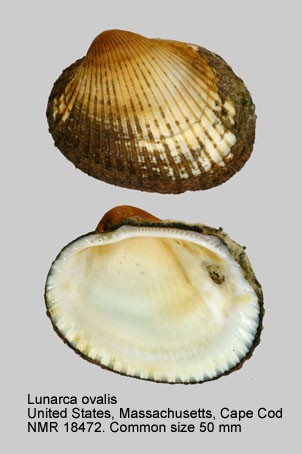Invasion History
First Non-native North American Tidal Record:First Non-native West Coast Tidal Record:
First Non-native East/Gulf Coast Tidal Record:
General Invasion History:
Anadara ovalis is native to the Northwest Atlantic. It is rare in Massachusetts Bay, but common in coastal waters from Cape Cod to the Gulf of Mexico. It is usually found on mud or sand, at polyhaline to euhaline salinities (18-35 PSU) (Wass et al. 1972; Morris 1975; Gosner 1978). It was among the 20 most abundant bivalves in Long Island Sound in the 1800s (Miller 2000).
North American Invasion History:
Invasion History on the West Coast:
A dead shell of Anadara ovalis was found in 1967 at Coyote Point, on San Francisco Bay, along with dead shells of Mercenaria mercenaria and Argopecten irradians (Wicksten 1976, cited by Carlton 1979). Live animals or dead shells of this bivalve were probably introduced with oysters planted in San Francisco Bay, from Long Island Sound, in the late 1800s (Carlton 1979; Miller 2000). There is no evidence that a breeding population existed in San Francisco Bay.
Description
Anadara ovalis is a marine bivalve with a thick, strongly ribbed shell. The hinge line bears numerous teeth, arranged in a line on both valves. Both valves have prominent beaks which almost come into contact. The shell is heart-shaped in a side view. Both shells have about 35 radiating ribs. The shell is white, but it is covered with a thick and bristly greenish-brown periostracum. The blood of A. ovalis contains hemoglobin (found in few bivalves), and is bright red. This bivalve does not have a siphon. Its shell typically reaches 50 mm. Ark shells occasionally attach to rocks and shells with byssus threads. (Description from: Morris 1975; Gosner 1978)
Taxonomy
Taxonomic Tree
| Kingdom: | Animalia | |
| Phylum: | Mollusca | |
| Class: | Bivalvia | |
| Subclass: | Pteriomorphia | |
| Order: | Arcoida | |
| Family: | Arcidae | |
| Genus: | Anadara | |
| Species: | ovalis |
Synonyms
Anadara ovalis americana (Wood, 1828)
Anadara ovalis pexata (Say, 1821)
Arca campechiensis (Gmelin, 1791)
Lunarca ovalis (Bruguiere, 1789)
Potentially Misidentified Species
None
Anadara trasversa
Transverse Ark Shell
Ecology
General:
Anadara ovalis, commonly known as the Blood Ark, is a suspension-feeding bivalve found in sandy and muddy subtidal bottoms, in polyhaline-euhaline salinities (Wass 1972; Morris 1975; Gosner 1978). Ark shells occasionally attach to rocks and shells with byssus threads. This bivalve has planktonic veliger larvae (Miller 2000).
Food:
Phytoplankton
Trophic Status:
Suspension Feeder
SusFedHabitats
| General Habitat | Unstructured Bottom | None |
| General Habitat | Oyster Reef | None |
| Salinity Range | Polyhaline | 18-30 PSU |
| Salinity Range | Euhaline | 30-40 PSU |
| Tidal Range | Subtidal | None |
| Vertical Habitat | Endobenthic | None |
| Vertical Habitat | Epibenthic | None |
Tolerances and Life History Parameters
| Minimum Salinity (‰) | 17.5 | Experimental, gradual transfer (Castagna and Chanley 1973) |
| Maximum Length (mm) | 50 | Morris 1975 |
| Broad Temperature Range | None | Cold temperate-Tropical |
| Broad Salinity Range | None | Polyhaline-Euhaline |
General Impacts
Anadara ovalis has not established an introduced population and has no known impacts beyond its native range.Regional Distribution Map
Non-native
Native
Cryptogenic
Failed
Occurrence Map

References
Abbott, R. Tucker (1974) American Seashells, Van Nostrand Reinhold, New York. Pp. <missing location>Carlton, James T. (1979) History, biogeography, and ecology of the introduced marine and estuarine invertebrates of the Pacific Coast of North America., Ph.D. dissertation, University of California, Davis. Pp. 1-904
Castagna, M.; Chanley, P. (1973) Salinity tolerance of some marine bivalves from inshore and estuarine environments in Virginia waters on the western mid-Atlantic coast., Malacologia 12(1): 47-96
Gosner, Kenneth L. (1978) A field guide to the Atlantic seashore., In: (Eds.) . , Boston. Pp. <missing location>
Miller, Alexander Whitman (2000) <missing title>, University of California at Los Angeles, Los Angeles. Pp. <missing location>
Morris, Percy A. (1975) A field guide to shells of the Atlantic, Houghton-Mifflin, Boston. Pp. <missing location>
Wass, Melvin L. (1972) A checklist of the biota of lower Chesapeake Bay, Special Scientific Report, Virginia Institute of Marine Science 65: 1-290
